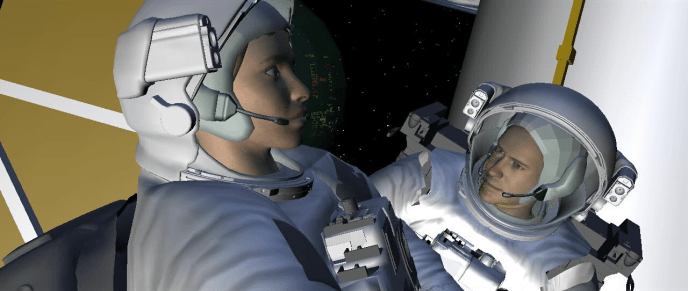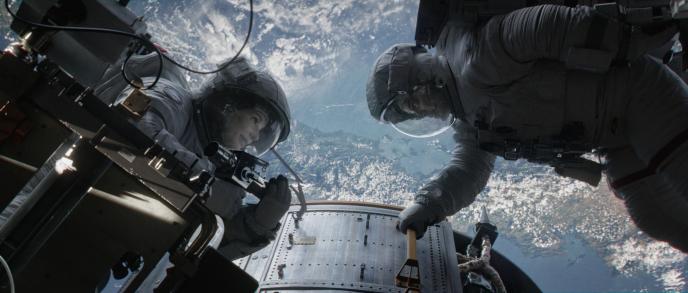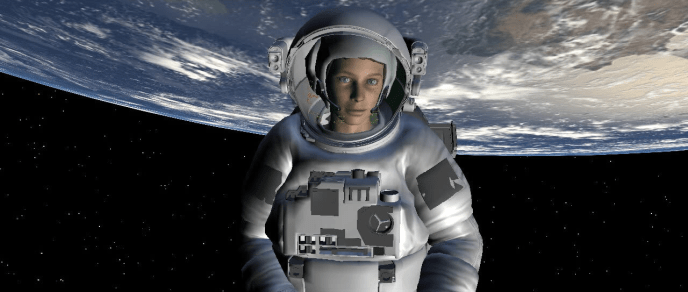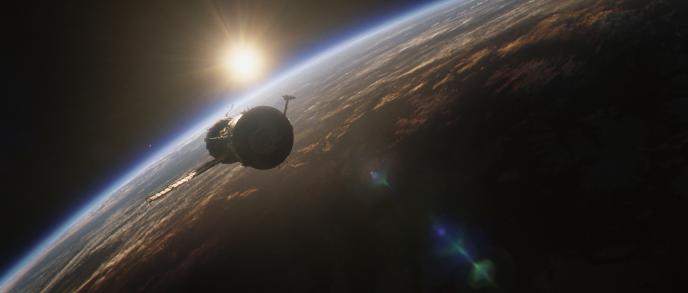Preparing for Gravity
A commercial and critical success that landed an incredible 10 Oscar nominations and seven wins, Alfonso Cuarón’s Gravity was a cinematic milestone.
Beyond the sheer cinematic spectacle, however, the film was also a landmark moment for both Framestore and the wider VFX industry. It presented a rare moment where filmmaking necessity leads to a paradigm shift in terms of both technology and creativity. As well as driving forward LED technology, previs and animation, the film represented a feat that effectively reframed what studios and cinemagoers alike would expect from films set in space.
The film secured Framestore its second VFX Oscar and proved to the world that Framestore was capable of breathing life into far more than the deft, nuanced creature and character work it was known for. With many key players still working at Framestore in creative, technical, production and managerial roles, we’re using the film’s anniversary to take a look back at how the experience shaped their careers and the impact it is having to this day.
This segment digs into the initial pitch, prep and planning for the landmark film.

Fiona Walkinshaw is Framestore’s CEO, Film & Episodic. At the time she was the company’s Director of Production - part of the team who brought the feature into Framestore, and ensured the film’s groundbreaking VFX was delivered on time, and to budget.
Fiona Walkinshaw: “At the time Framestore was working maybe two or three films a year as opposed to the 30 or so we make today. So, when we started in 2010, it was Gravity and 47 Ronin.
“We knew from the moment we saw the script that nothing like it had been done before. There was a seed of excitement around the project from the get-go - I remember Alfonso telling Tim [Webber, VFX Supervisor] the story and Tim being so caught up in it all that he was physically exhausted by the excitement of it.”

Tim Webber is Framestore’s Chief Creative Officer. He was Gravity’s VFX Supervisor.
Tim Webber: “By 2010 I’d suped a variety of film and advertising projects, and I was itching to do something different. I’d worked with Alfonso on Children of Men and when it came to Gravity I was immediately interested - I recognised the challenge and the fact that it would require whole new ways of working.
“When we first started talking about the project it wasn’t even greenlit. The techniques and methodologies hadn’t been worked out and the casting wasn’t finalised. It was at quite a loose stage for some time, and [producers] David Heyman and Chris DeFaria were really key in bringing it all together.”
Today, Charles Howell is Framestore’s President, Global Advertising & Content, leading this side of the company’s business from its New York studio. He worked on Gravity as Visual Effects Producer, and highlights the studio-wide buzz that the project generated.
Charles Howell: “I was supposed to work on another film at Framestore, but I'd heard of this top secret Alfonso Cuarón project that was starting to gain traction. I got my hands on a script - which was a lot easier to do back then! - and thought it was amazing so I actively petitioned to work on the project.
“There was a brilliant team of people at Framestore I really wanted to work with, and a project we wanted to work for - a brilliant filmmaker and script. It was an incredibly challenging project, but even at its most difficult it definitely felt like we were all in the right place at the right time.”

The complex nature of the film’s VFX meant that turning up to shoot ‘on the day’ wasn’t an option. The decision to make the entire film in previs was unusual at the time and a first for Framestore, but an absolute necessity.
Fiona Walkinshaw: “Previs had obviously been around for quite some time, but it was the first time that Framestore had made the film in vis before actually making the film. The process evolved during pre-production, and Alfonso understood and bought into it straight away - it was the de facto editorial tool he had to use, making previs and techvis absolutely essential to Gravity.”
Vincent Aupetit is Creative Director, Pre-Production at Framestore. When Gravity came in-house he’d been working with the studio as an animator, though his credit on the film would ultimately be Previsualisation Artist - a designation that would fundamentally shape his career.
Vincent Aupetit: “I’d been trained as an animator, but while I was passionate about the craft I was always more intrigued by the ‘bigger picture’ when it came to filmmaking: camera work, shot composition, editing, the overall pace and the different elements of visual storytelling. I had a passion for animation, but more so for movies themselves. Gravity gave me an opportunity to combine these passions and actually put a name to it: previs.
Vincent found himself part of a small team from Framestore, working directly with Cuarón on the film’s greenlight pitch.
Vincent Aupetit: “It took us around three months to block out the very first shot of the movie: a nine-minute oner introducing the concept of the film, its weightlessness, its cast, and that feeling of being out there, lost in space. When the movie was greelit, we set out to block out more sequences - some previs-ed in stereo, which I believe was a first - until the team grew around to become a fully-fledged previs enterprise that would run for two years.
“When the team grew I was - rightly! - deemed too inexperienced to take on a supervisory role, but remained a key member of the visualisation team due to my knowledge of the show and director. This was an extraordinary period, learning from seasoned previs artists and animation supervisors and seeing the film gradually come together as we tackled challenge after challenge. There were so many things to discover, so many things that we were trying that had never been done before.”

Stuart Penn is a VFX Supervisor whose credits include Mickey 17, Avengers: Endgame and Moon Knight. While his on-screen credit for Gravity is CG Sequence Supervisor, his role evolved as the project moved forward.
Stuart Penn: “I had a few roles on the film as it progressed from pre-production to delivery.
Initially, I was part of the pre-production team tasked with working out how we could shoot the film. This involved working closely with Tim, SFX and the previs team. This overlapped into looking at how we would light the shots and the development of the lightbox and motion control robots. I worked closely with DOP Emmanuel ‘Chivo’ Lubezki on the lighting design and the digital pre-light of the previs that would guide our lighting on set. I supervised the tech vis team that took the previs and worked out we could film each shot. Providing pre-programmed moves for the motion control and lightbox set-ups and stage layouts for other types of shot.”
Prior to his successful VFX career, Stuart led a very different life as a research physicist - a role that was to prove useful when it came to exploring and understanding Gravity’s weightless setting.
Stuart Penn: “Tim [Webber] chose me for the role because he knew my physics and technical background. An understanding of the physics of space and motion was a big help, as were the problem-solving skills that time had taught me.”
It took over a year to finalise Gravity’s previs, which provided a detailed blueprint for the creative team, allowing them to carefully map and choreograph the film’s camera movements, timings and lighting. As well as helping plan and prep the action, drama and Chivo’s breathtaking cinematography, previs would also assist the film’s cast. Cuarón and Webber would talk Sandra Bullock and George Clooney through the previs before each shot, helping them understand the sequence, the beats they needed to hit and how far they might be able to deviate from the plan.
